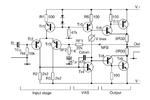Farad22
Junior Member level 2
Hi,
Lately I'm reading a book on (audio) amplifier design. I have some questions about the Miller capacitor in the attached schematic.
From this audio book I read:
"The global (overall) feedback factor at low frequencies is sufficient to linearise the VAS, while at high frequencies shunt negative feedback through Cdom conveniently takes over VAS-linearisation while the overall feedback factor is falling."
I see how the global feedback works, but not the local feedback by the Miller capacitance. Where does the feedback action take place and how is the VAS (Voltage Amplification Stage) linearised?
Thanks in advance.
Lately I'm reading a book on (audio) amplifier design. I have some questions about the Miller capacitor in the attached schematic.
From this audio book I read:
"The global (overall) feedback factor at low frequencies is sufficient to linearise the VAS, while at high frequencies shunt negative feedback through Cdom conveniently takes over VAS-linearisation while the overall feedback factor is falling."
I see how the global feedback works, but not the local feedback by the Miller capacitance. Where does the feedback action take place and how is the VAS (Voltage Amplification Stage) linearised?
Thanks in advance.


